Tricycles are themselves rather unusual on the road today, though in Victorian times they were relatively common. Even today's tricycles have relatively unusual versions in their ranks- such as the folding recumbent tricycles made by Greenspeed. (external link)
There is a list of motorized tricycles in Wikipedia.
This page, in accordance with the philosophy of The Museum of RetroTech, deals only with really unusual tricycles.
THE RUDGE ROTARY TRICYCLE
 |
| Left: The Rudge "Coventry" Rotary Tandem Tricycle: 1884
Saddles for two. This famous machine demonstrates that the designers of the day were not afraid of asymmetry. It is propelled by the big wheel, driven by both riders, and steered by the two small wheels, which are interlinked by rods, and apparently can be controlled from either of the spade-shaped handles. These don't seem to be at all suited to applying any leverage on the steering, and their operation is mildly mysterious.
|
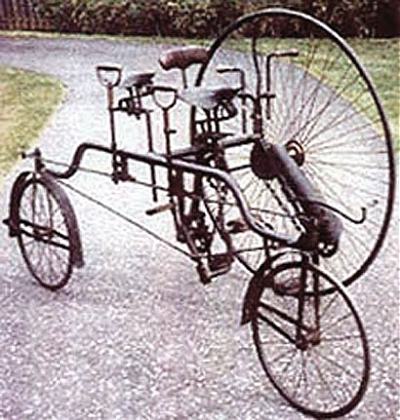 |
| Left: The Rudge "Coventry" Rotary Tandem Tricycle: 1884
The image quality here is somewhat less than perfect but it does give a good view of the two sets of pedals and two chains driving the big wheel.
It was claimed as an advantage of this format that it was only necessary to find two tracks between the bumps as opposed to the three required for a conventional tricycle.
This example is at the Metz Bicycle Museum in Freehold, New Jersey.
|
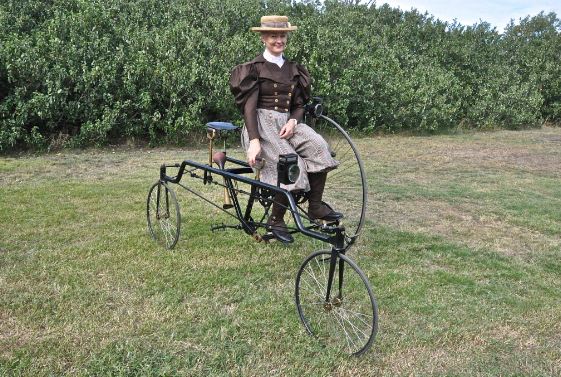 |
| Left: The Rudge "Coventry" Rotary Tandem Tricycle: 1884
A rather better picture of a Rudge Rotary Tandem. Note the bulb horn just to the left of the lady.
|
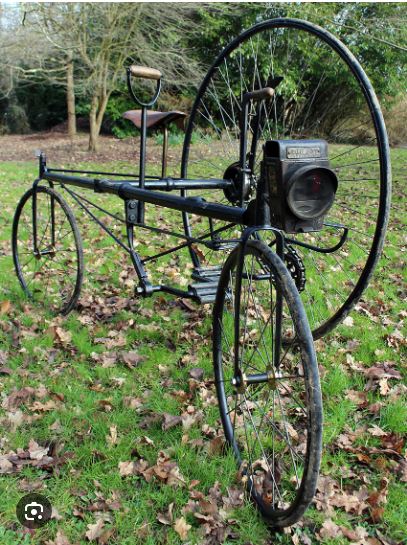 |
| Left: The Rudge "Coventry" Rotary Tricycle: 1884
This version is a single-person Rudge tricycle. Note the unguarded chain drive and the big front lamp.
There is a handle to the right of the saddle, and it looks as if it operates a brake drum mounted on one side of the big wheel; this is presently unconfirmed. The small wheels have no visible brakes.
On this machine the small wheels have no mudguards.
|
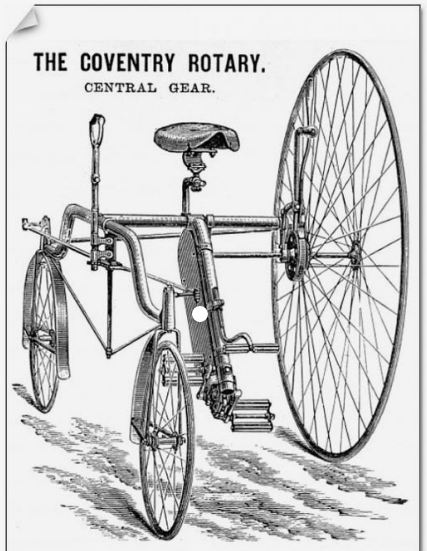 |
| Left: The Rudge "Coventry" Rotary Tricycle: 1884
Another picture of a single-person Rudge tricycle. This time the chain is fully encased.
|
THE OLDRIEVE TRICYCLE
 |
| Left: The Oldreive Tricycle: 1882
This is a tricycle invented by Charles Wood Oldreive, who took this photo in 1882. The rider sat inside the large wheel; its great diameter was to allow easier running over irregular ground. Oldreive called his tricycle "The New Iron Horse".
The tricycle was propelled by crank handles, with gearing concealed in the domed hub caps. Seems unlikely it went very fast.
US patent 245,012 was issued to Charles Wood Oldreive of Chelsea, Massachusetts, in 1881. He seems to have been best known for walking on water with a small boat on each foot, but this is currently unconfirmed.
There is more info on Charles Wood Oldreive here.
|
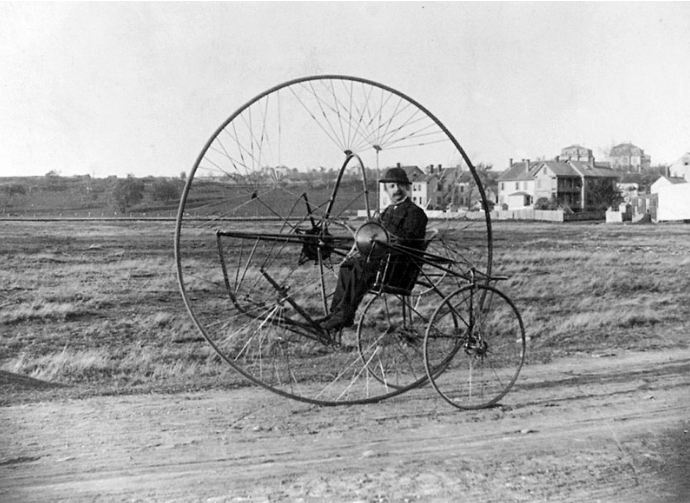 |
| Left: The Oldreive Tricycle: 1882
To get inside the big wheel presumably involved threading yourself through the spokes. Doesn't look as if it would be easy. I say this is a tricycle rather than a monowheel, because of the significant size of the rear two wheels.
This photo looks very much as if it was taken on the same day as the one above.
|
 |
| Left: Top View of The Oldreive Tricycle: 1882
Showing the handles for moving it along, geared to each side of the wheel.
But how do you steer it? The rear wheels swivel and the chains attached to them are connected to wires running through the centres of the wheel hubs.
Source: US patent 245,012
|
 |
| Left: Side View of The Oldreive Tricycle: 1882
Mr Oldreive appears to have made a basic mistake by using hand-power. You get much more power from your legs, which is why bicycles have pedals rather than handles.
The lever marked l is a crude brake that dragged on the ground when applied by the rider; does not sound very practical to me.
Source: US patent 245,012
|
THE KENDRICK TRICYCLE
 |
| Left: The Kendrick Tricycle: 1936?
The Kendrick tricycle is noted for having Ackerman steering on the two wheels at the front. The other two-wheels-first tricycles on this page appear to have the same setup, though Kendrick did apparently hold a patent related to steering. In fact the Kendrick had a reputation of being susceptible to bump-steer and not easy to control.
There is more info here.
|
THE EAGLE TANDEM TRICYCLE
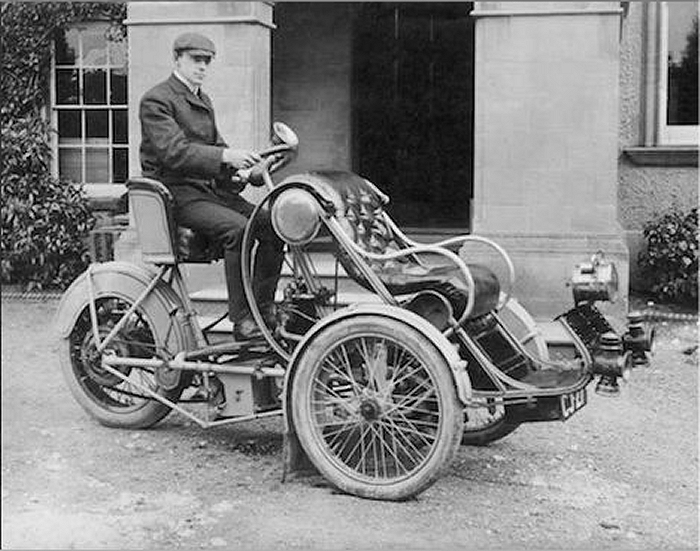 |
| Left: The Eagle Tandem: 1903
This is H F S Morgan on an 8 HP Eagle Tandem, which it could be argued was more of a forecar than a tricycle. Note the vulnerable situation of the passenger at the front. The engine was by DeDion. Mr Morgan famously received a summons for exceeding the 12 mph speed limit on this machine; he went on to produce the famous three-wheel Morgan sports cars, with the same wheel arrangement but the engine at the front.
There is more info here.
|
THE AMPHIBIOUS TRICYCLE
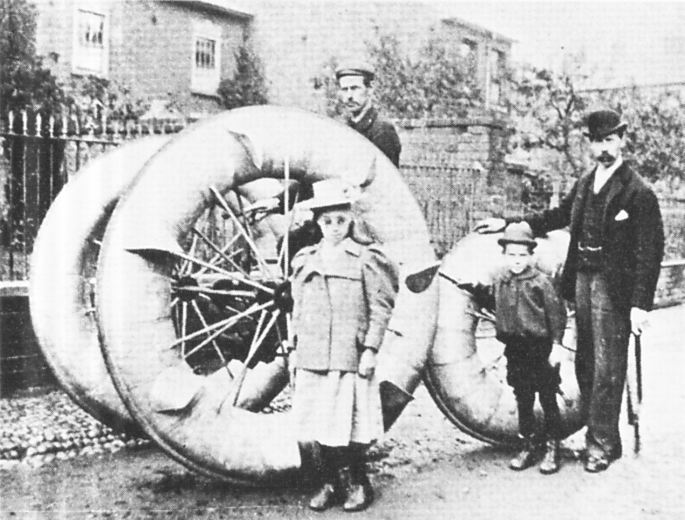 |
| Left: The Amphibious Tricycle: 1885
This was built by Mr H Savage of Worcester in 1895. It was reportedly peddled for some distance up the River Severn and then ridden onto dry land. Note the scoops fitte to the front wheels for propulsion in the water.
|
THE POLICE BONDAGE TRICYCLE
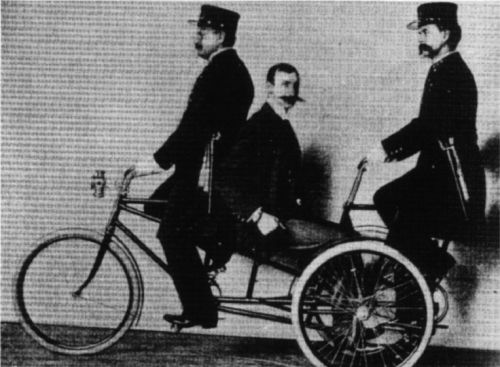 |
| Left: The Police Bondage Tricycle: 1898
This remarkable conveyance was built in 1898 by the Davis Sewing Machine Co, of Dayton, Ohio. The intention was that arrested persons could be swiftly conveyed back to the police station under restraint. It was actually called "The Police Patrol Tricycle".
It can be just discerned in the picture that the unfortunate gentleman in custody is secured to the tricycle at wrist and ankle by manacles and leg irons.
The policeman at the rear has his own set of pedals so he can contribute to propulsion.
I think it is safe to assume that the idea did not take off.
|
THE GIANT EIGHT-MAN TRICYCLE
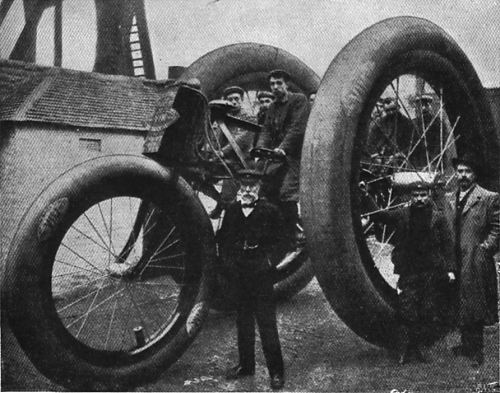 |
| Left: The Giant Eight-Man Tricycle: 1899
This giant tricycle was built as a promotional tool for the Boston Woven Hose and Rubber company. It was to promote for "Vim" tyres. The Vim label can be clearly seen on the two nearest tyres, and it also appears on the plate just above the front fork.
The chap with the cap in the centre of the photo looks like he is in charge.
This machine required eight men to pedal it, and one to steer, though only seven are visible in the photograph. The lugubrious chap at the front is clutching the steering-wheel.
Date of photo 1899.
|
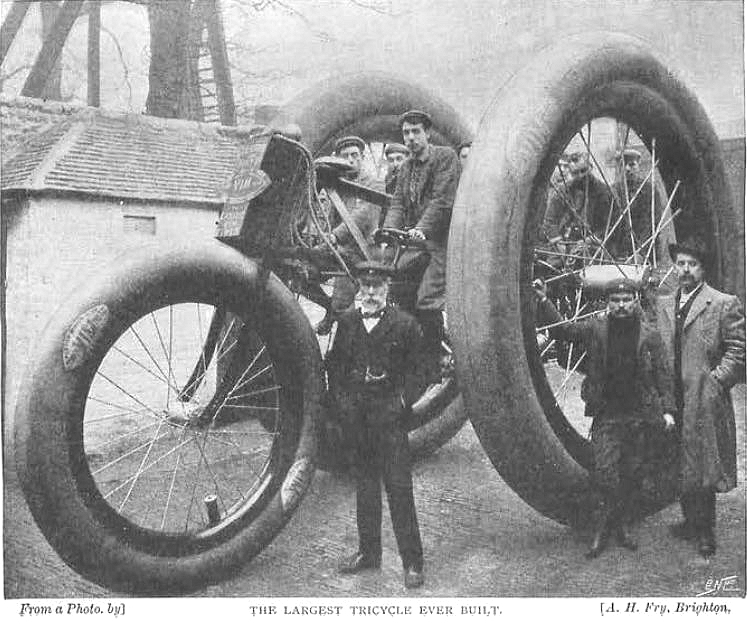 |
| Left: The Giant Tricycle: 1899
A better version of the picture. The Strand article in which this image appears states that it was built in the USA in 1897, and was shipped to Britain in 1899, where it was displayed in a cycle shop on Holborn Viaduct, London. The two side wheels were 11 feet, and the front wheel 7 feet in diameter.
According to the Strand, it required 8 men to pedal and one more to steer, and weighed nearly a ton. The bearings must have been well-designed, as one man could push it along on a level surface.
Source: The Strand Magazine Vol XVII-4 1899 (exact date currently unknown)
|
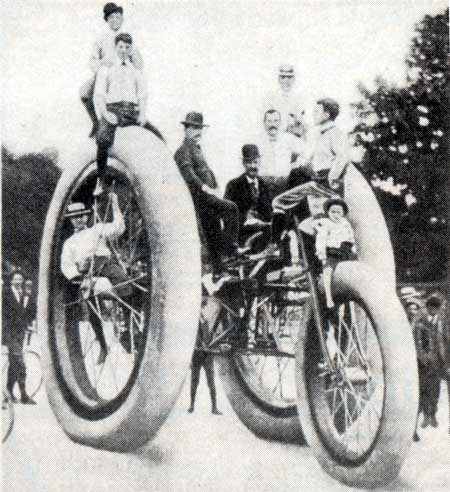 |
| Left: The Giant Tricycle Strikes Again: 1898.
I have found another picture of this machine. It was taken in Canada in 1898. The caption states it took six men and a boy to propel it, (Eh? I think we can assume the "boy" bit is a journalistic joke) and that the rear wheels were 14 feet in diameter.
The tricycle was reported to be hard to control in wet weather, as its balloon tires were completely free from tread.
|
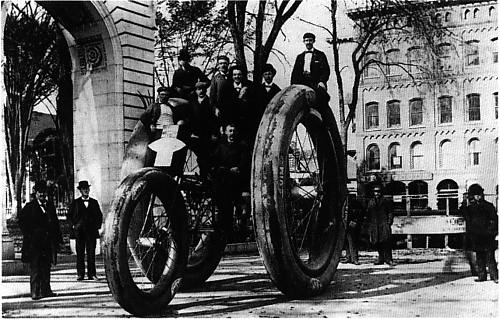 |
| Left: The Giant Tricycle Reveal'd!
This machine has finally been tracked down. It was indeed a promotional stunt, publicising "VIM" tyres made by the Boston Woven Hose and Rubber Company. In 1985 ten men rode it 37 miles from Nashua to Concord, New Hampshire, to take part in the Merchant's Week Bicycle Parade; not that it was strictly speaking a bicycle.
It weighed 1900 pounds, presumably including the crew. Apparently it terrified all the horses it met, and an advance party was required to throw blankets over the heads of said horses to stop them bolting.
|
THE ENCLOSED TRICYCLES
 |
| Left: Humber Enclosed Triplet: date unknown 1890s?
This is one way of getting weather protection, though I would have thought it was rather heavy, and there is no windscreen. Perhaps this is why the rider looks less than happy. It is unusual for a tricycle to be called a triplet; that usually referred to a three-man bike.
There is an enigmatic black box behind the front wheel, which appears to be resting on the ground.
An image search yielded nothing.
Source: Originally probably the French journal La Nature, judging by the signature of Poyet, who did much work for them. It has gained an English caption.
|
THE ELEPHANT TRICYCLES
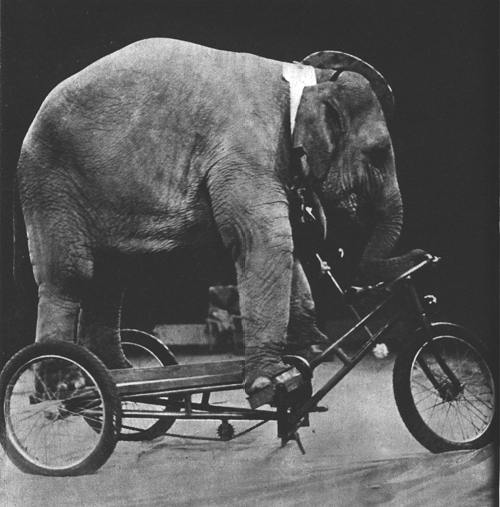 |
| Left: Elephant Tricycle: date unknown 1950s?
I think no further comment is required.
So I shall naturally add one.
The tyres appear to be compressed flat, but since the eletricycle is manoeuvring on some sort of fabric this is by no means certain. The picture probably dates to the 1950's.
Lilliput magazine
|
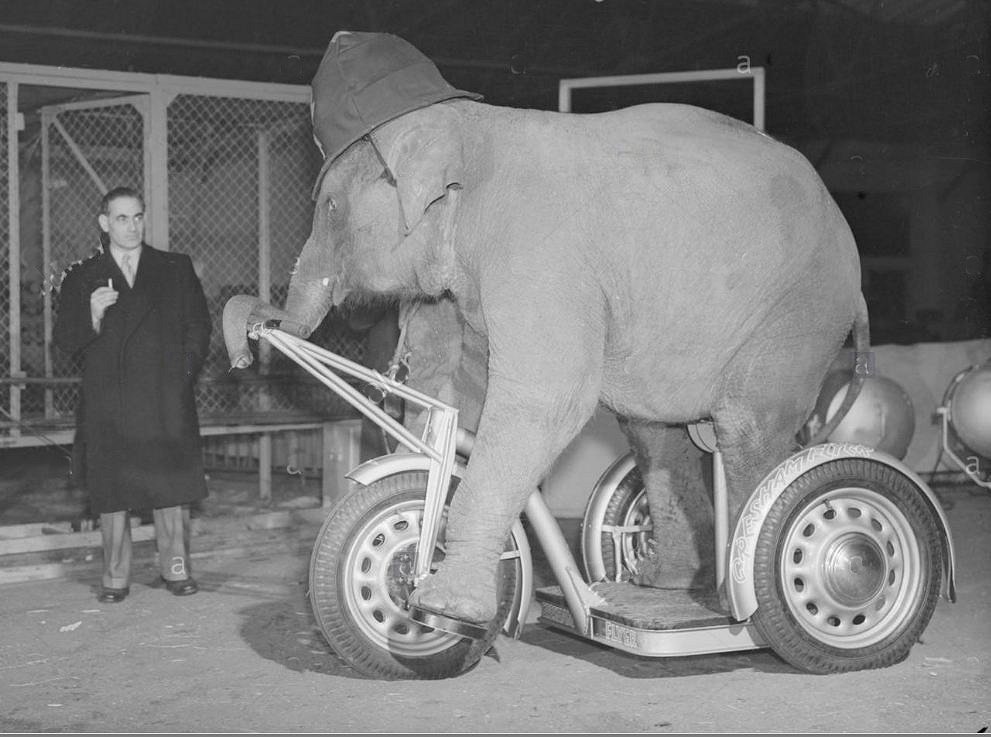 |
| Left: Elephant Tricycle: 18th December 1952
The elephant seen here was said to be riding a Gresham Flyer tricycle. This was a famous brand of children's tricycle; the one shown is very clearly not a standard model, but a special with lorry wheels. Notice how the tyres are compressed.
It is not clear if the elephant is actually pedalling or not; it does seem to be steering, with its trunk draped on top of a tiller attached to the front wheel. There is a huge saddle at the rear supported by the post between the back legs.
This is probably elephant Joan and her trainer Joseph Vinicky; see the picture just below.
Good evening, constable.
|
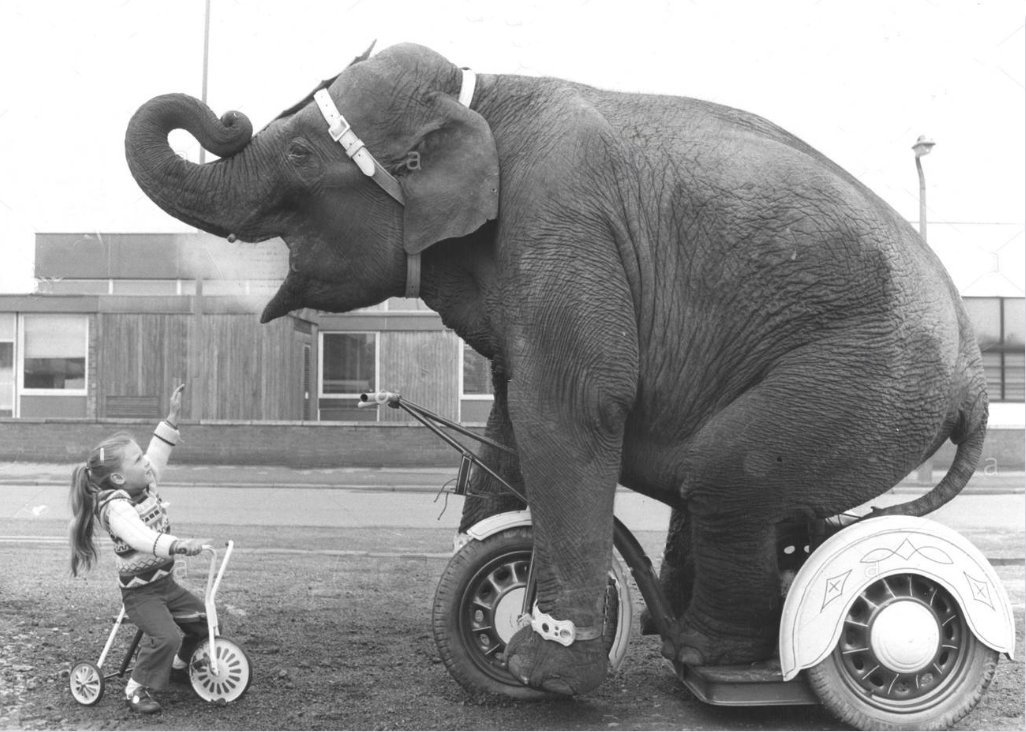 |
| Left: Elephant Tricycle: 1950s?
Tricycle meets tricycle. This is the same tricycle as seen just above, but the rear mudguards have been altered.
Whether it is the same elephant is uncertain.
|
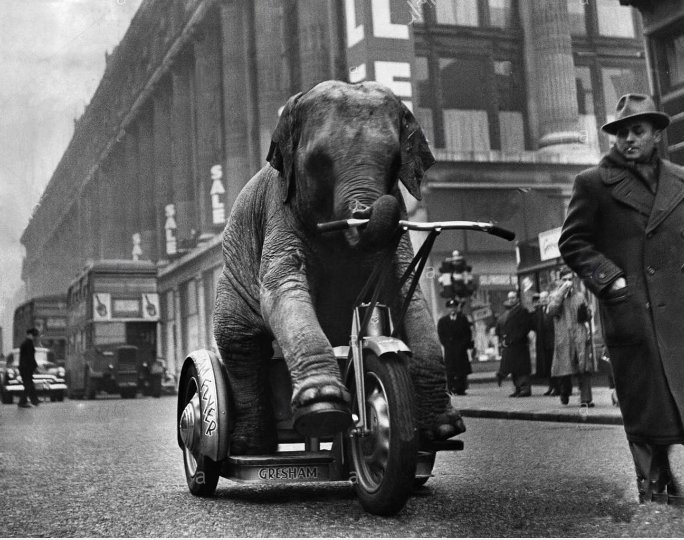 |
| Left: Elephant Tricycle: 1953
Joan the baby elephant rides her tricycle down Oxford St in London, allegedly on her morning exercises from Jack Hylton's Circus at Earls Court, though I suspect it was really a publicity stunt. I don't believe Joan did this every morning. Her trainer Joseph Vinicky, walks beside her. There is some more information on Joseph Vinicky here.
Note the Gresham Flyer advertisment on the front of the tricycle.
Jack Hylton has a Wikipedia page but it does not mention his circus.
Photograph January 1953. Looks like Selfridges in the background,
|
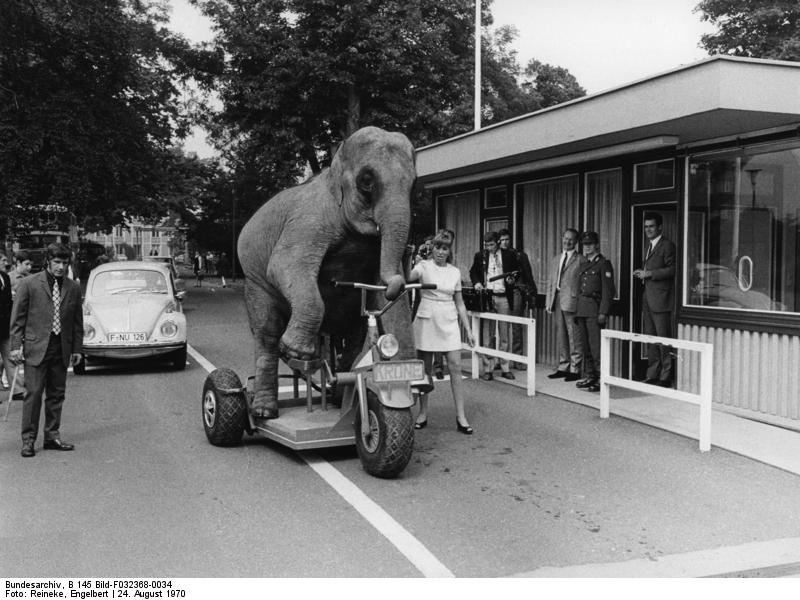 |
| Left: Elephant Tricycle: 1970
Pictured in Germany in August 1970. More information, but not much more, here.
|
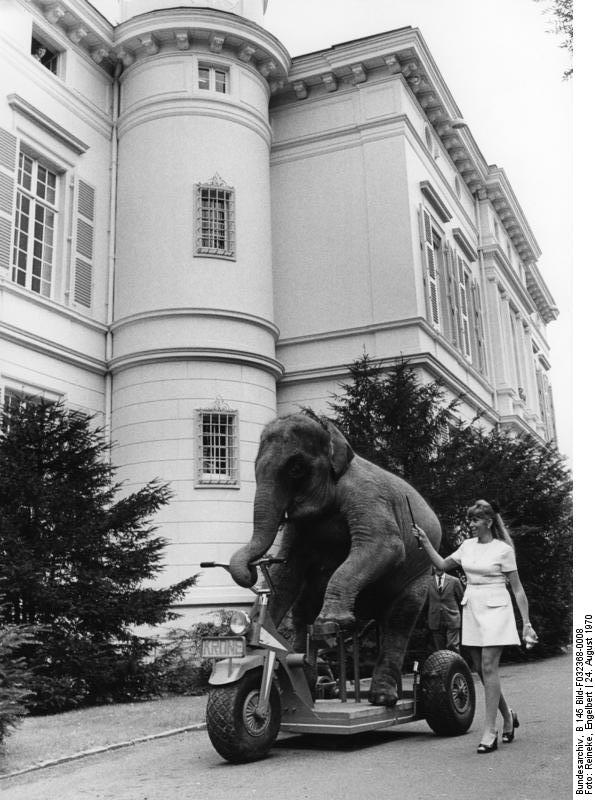 |
| Left: Elephant Tricycle: 1970
Photographed in Germany in August 1970, on the same occasion as the picture above. The sign on the front says 'KRONE'. This refers to Circus Krone based in Munich.
|
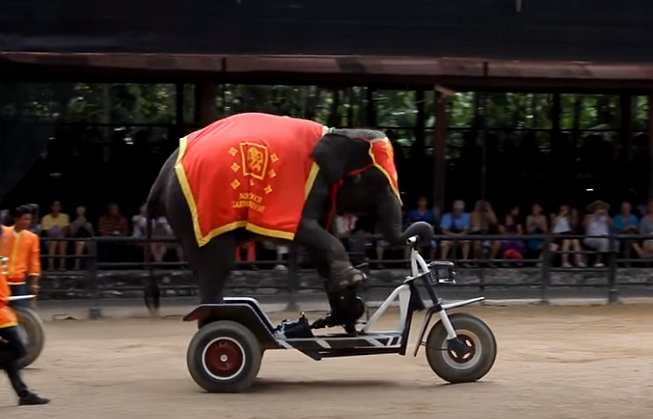 |
| Left: Elephant Tricycle: 2012
There is indisputable evidence on YouTube that elephants can pedal tricycles and steer them. They seem to be perfectly happy to do it.
|
THE STREET-PRINTING TRICYCLE
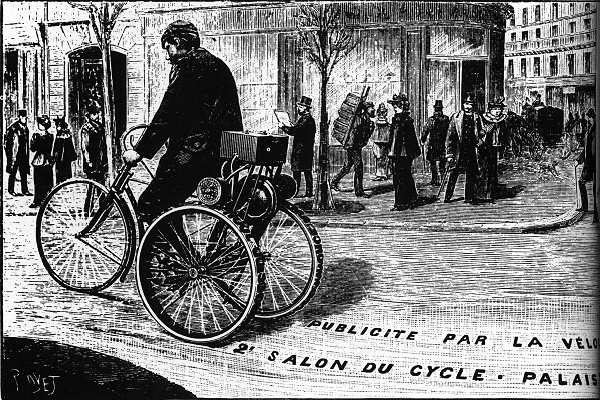 |
| Left: The Street-Printing Tricycle: 1895.
This extraordinary tricycle appeared in 1895. The solid rubber wheels are fitted with printing blocks that were continuously inked to leave printing on a hard road surface. The machinery at the rear is not an engine, but includes two inking rollers and a tank for gravity-feed ink supply. How long such a message would remain legible on a busy street where most of the traffic was horse-drawn is a question that I, for one, do not feel qualified to answer. Quite possibly the municipal authorities objected strongly to having their roads written on. At any rate, the idea seems to have sunk without trace, and the world is not the poorer.
I was under the impression that this machine was featured in La Nature in 1895, but I have been unable to find it there.
|
 |
| Left: Street-Printing in Paris: 1924
Here tricycles are no longer the favoured means, but in France in 1924 street-printing was clearly a thing.
Source: Popular Science Monthly for Dec 1924
|
The idea lives on! See the Chalkwriter; a chalk-printing bicycle built by Joshua Kinberg at Bikes Against Bush. (Thanks to Shannon for alerting me to this modern version)
The above link seems to be dead but you can see more information here.
 |
| Left: The Kinberg Chalkwriter in action: 2004
The Chalkwriter sprayed chalk onto the sidewalk from an array of rack-mounted aerosol cans, actuated by solenoids controlled by a PowerBook.
Kinberg, an instructor at the Parsons School of Design in New York, planned to take the ChalkWriter to the Republican National Convention, which was held in NYC from Aug 29 to Sept 4, 2004. However he was arrested in highly questionable circumstances, as described here.
Yes, I am aware that this is not strictly a tricycle. But you must take your street-printing where you find it.
|
 |
| Left: The Kinberg Chalkwriter: 2004
The Chalkwriter ready for action.
|
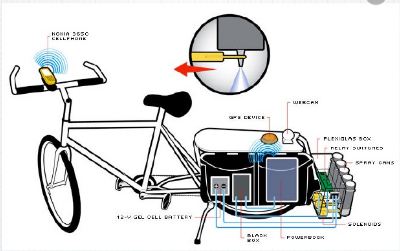 |
| Left: The Anatomy of the Kinberg Chalkwriter: 2004
Note the Nokia cellphone on the handlebars. This presumably transmitted the desired text to the Powerbook in the box at the rear. The text is barely legible, but a 12V battery and a 'black box' (to interface the Power book to the solenoids?) can be seen there.
|
TANDEM TRICYCLES
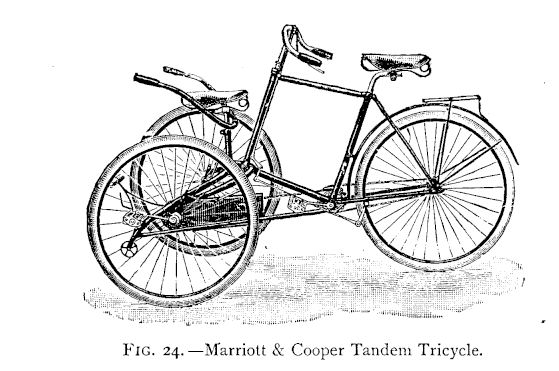 |
| Left: Marriott & Cooper tandem tricycle: 1888
This in-line tandem tricycle placed one of the riders in an excellent position to be first at the accident. It is pretty clear that both riders have pedals, but it seems that the front rider is not involved in the steering.
Marriott and Cooper were based in Coventry and at 1 Holborn Viaduct, London EC. The company was formed by Thomas Rushforth Marriott and Fred Cooper. For many years they had no factory of their own, all their machines being made by the Rudge Cycle Company.
|
 |
| Left: Marriott & Cooper tandem Tricycle: 1890
This model, designed by R W Smith, then assistant works manager of the Rudge Company, was first exhibited at the Stanley Show at the Royal Aquarium, Westminster, London, in January 1888. On the first specimen to leave the works Selwyn F Edge and G L Morris (the latter died 30th January, 1930, aged 65) beat the 100 miles road record, their time being 6 hrs 57 mins 32 secs.
In 1890, Edge, with J E L Bates (died 1st January, 1930, aged 62) as partner, again beat this record, time 5 hrs 30 mins 31 secs; this remained unbeaten till 1924. (No information has been found so far on what happened in 1924) It is a coincidence that S F Edge's two tandem companions should have died within a month of each other. I assume.
Evidence is accumulating that the man at the back does the steering. |
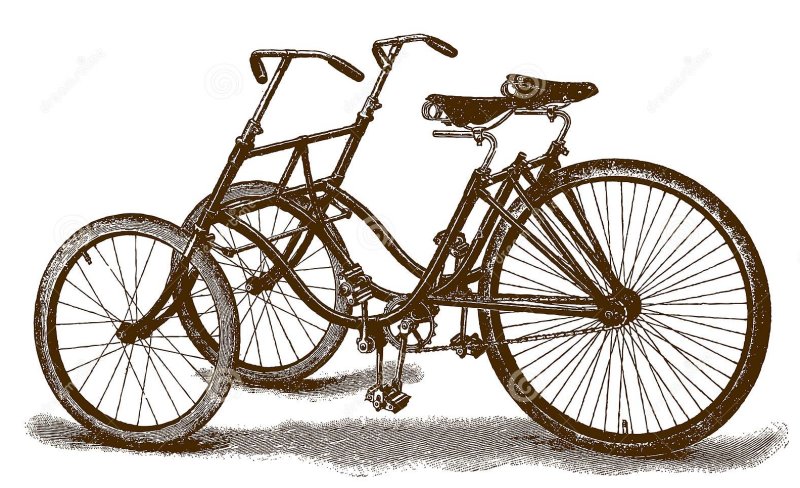 |
| Left: Sociable tandem tricycle of the First kind: 18??
This is one way to bulld a Sociable tandem, ie one where the riders are beside each other so they can talk. Two wheels at the front. The handlebars are linked.
Having one wheel at the back means only one chain is required to drive it, saving weight and complexity. Note the ingenious re-entrant pedals on each side.
Two wheels at the front was sometimes called the 'tadpole' configuration.
|
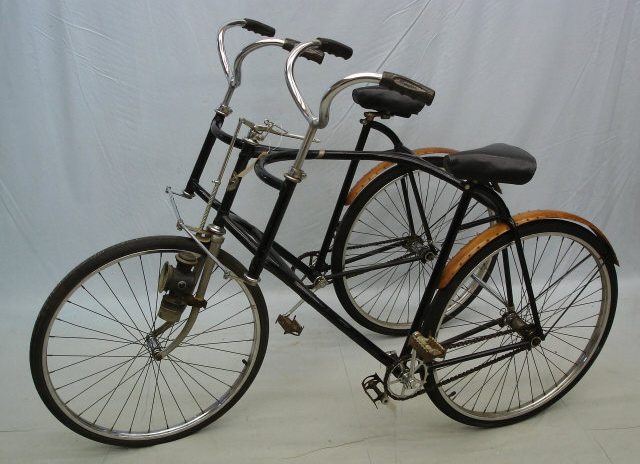 |
| Left: Sociable tandem tricycle of the Second kind: 18??
And here is the other way to bulld a Sociable tandem; two wheels at the back, with separate pedals and chain for each one, so no differential is required. The handlebars are linked.
|
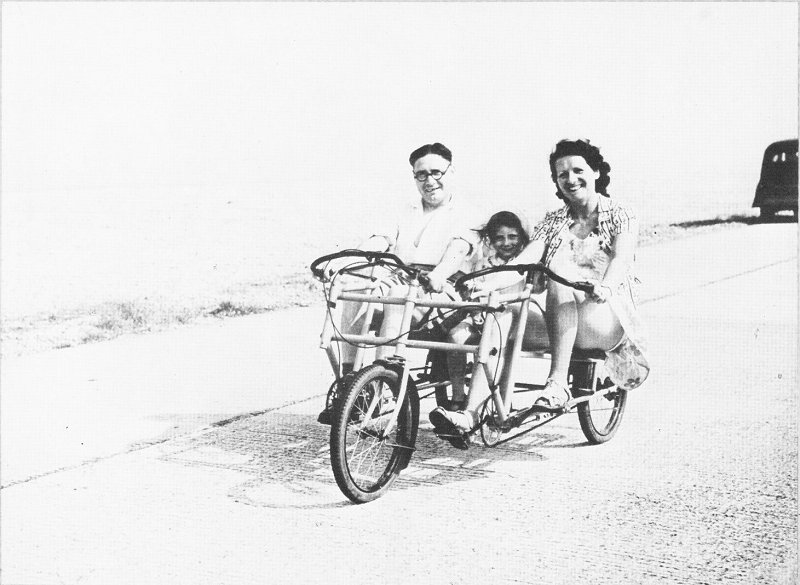 |
| Left: Sociable tandem tricycle: 195?
This is also a Sociable tandem, of the Second kind. This looks very like a holiday photo, (is that the sea in the background or a massive bank of fog?) so the machine was probably hired rather than used for everyday transport. The little girl appears to be on a back seat.
|
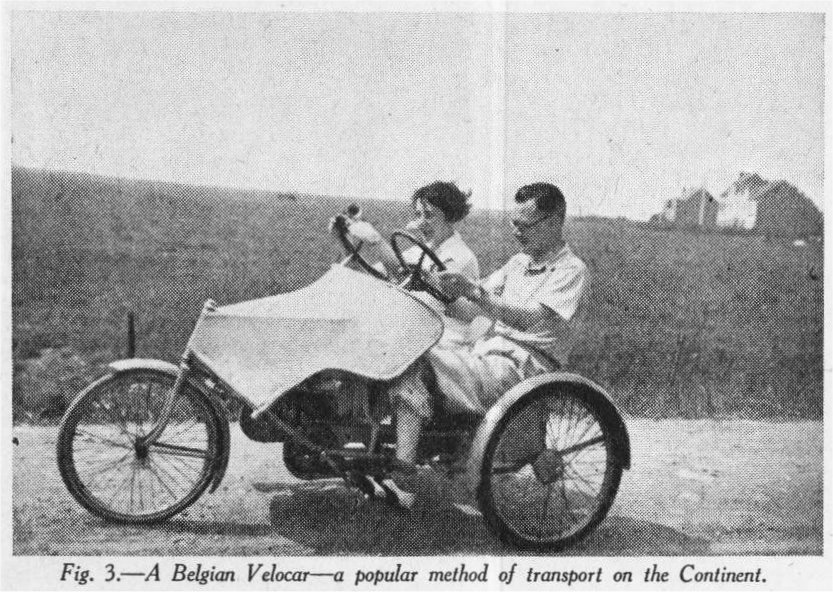 |
| Left: Sociable tandem tricycle: 195?
This sociable tandem tricycle is unusual in having two steering wheels and rudimentary bodywork. There seems to be separate chain drive to each wheel, so no differential is required.
According to Wikipedia, Velocar was the name given to velomobiles made in the 1930s and 1940s by Mochet et Cie of Puteaux, France. However no Mochet designs that look anything like this have been discovered so far, and certainly none with two steering wheels.
|
 |
| Left: Tandem tricycle: 195?
There is a little more to this picture of a tandem tricycle than immediately meets the eye. It was taken outside a children's home. The boy has an artifical left hand and what appears to be a hook for a right hand. The little girl at the back appears to have at least one real hand but two artificial legs.
|
HAND-POWERED TRICYCLES
The most effective way of propelling a bicycle or tricycle is by using your legs, because that's where the big muscles designed for locomotion are. If that's not an option, getting around by hand-power is not efficient, but it's a lot better than nothing. There certainly were hand-propelled invalid tricycles around in the 1950's.
 |
| Left: Hand-powered Invalid Tricycle: now
This tricycle is currently available for US$258 from the Unicef supply catalogue.
The front wheel (20in x 1.7in) does the steering, and includes brakes operated from the steering arm, apparently by pressing it down. Each back wheel (28in x 1.5in) is driven by hand-cranks connected by chain; this presumably allows turning on the spot, etc.
What is not too clear is how you are supposed to crank away with both hands and yet steer at the same time.
|
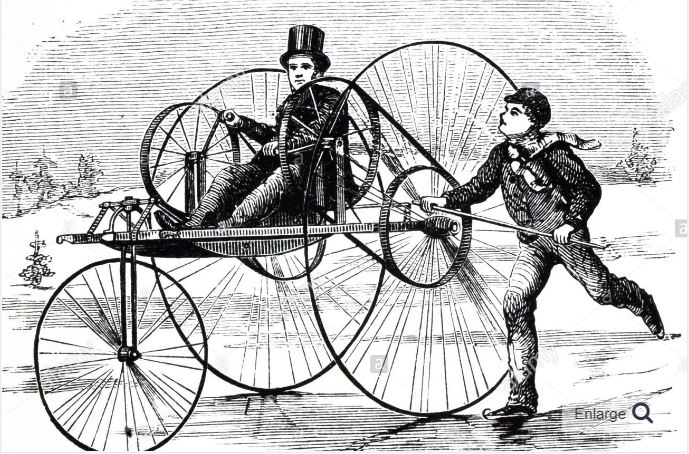 |
| Left: Hand-powered Tricycle: 18??
This tricycle was designed by George Glasgow. It was powered by two hand-cranks, and steered by the passenger's feet. Pretty much exactly the wrong way round for efficient propulsion and steering, and clearly not intended for use by invalids.
For some reason the machine is depicted on ice, (note young whippersnapper on skates) where it was not likely to be a practical proposition because of very poor traction.
No other information on the machine has currently been found, and no trace of a plausible George Glasgow.
|
 |
| Left: Hand-powered Tricycle: 18??
This tricycle was powered by two levers. What is intriguing is how it was steered. The great problem with any hand-propelled road vehicle is that you need to steer but both hands are busy with propulsion. So far as I can see the rear wheel of this contraption is steered by the rider tilting his body and so swivelling the curved back-rest attached to the top of the rear fork. No other information has currently been found.
Source unknown, but from the style of drawing I suspect a scientific/engineering journal, probably French. It might be possible to trace it from the signature on the drawing.
|
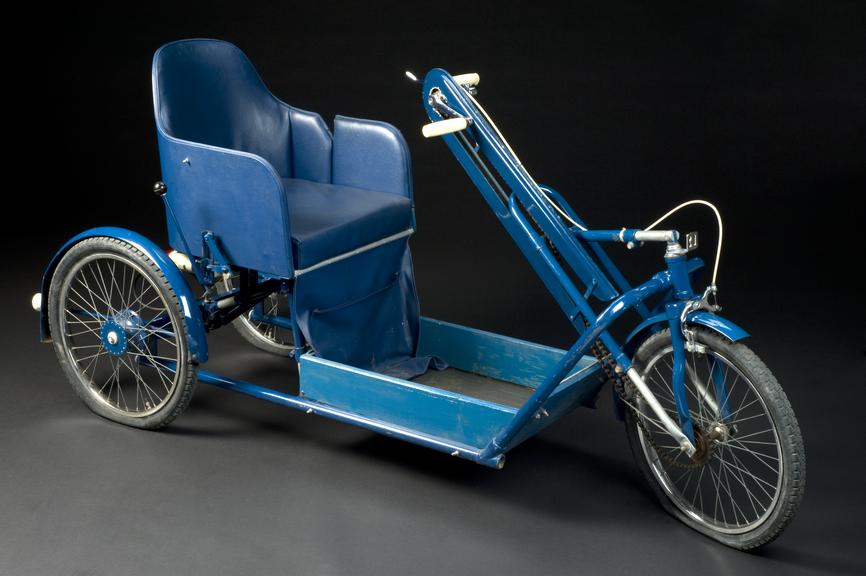 |
| Left: Hand-powered Invalid Tricycle: 1970-1975
This tricycle was powered by a single hand-crank. It was made by R.A. Harding of Bath and was available for invalids from 1970 to 1975. This example is in the Science Museum collection.
It has a very odd steering system, with a big U-shaped fork inside the chain. It appears that only large-radius turns are possible because the frame prevents the front wheel assembly turning much, and cranking away with the cranks displaced far to one side would have been difficult.
There is a conventional brake on the front wheel, operated by a lever just behind the hand-cranks. There is a handbrake on the right-hand side of the cockpit.
|
 |
| Left: Hand-powered Invalid Tricycle: 1655
The first known hand-powered tricycle was a wheelchair built in 1655 by a disabled German man, Stephan Farffler. He was a watch-maker, and this no doubt helped with the gearing.
|
 |
| Left: Hand-powered/Petrol Invalid Tricycle: 1936
It is not clear if the model shown is electric or petrol-powered; from the number of controls visible it was probably petrol. It is believed that the two big levers allowed hand-propulsion, but this is not currently proven.
The Argson Runnymede tricycle was designed in South Africa, but manufactured in Britain by the Stanley Engineering Co Ltd of Egham, Surrey, which had started out making self-propelled invalid carriages under the 'Argson' name in the 1920s. Both electrically-powered and Villiers petrol-engine versions were made, one of the latter being used for an heroic crossing of the Alps in 1947.
Runnymede production commenced circa 1936 and ended in 1954 when Stanley Engineering was bought by C B Harper Ltd.
|
THE FIREFIGHTING TRICYCLE
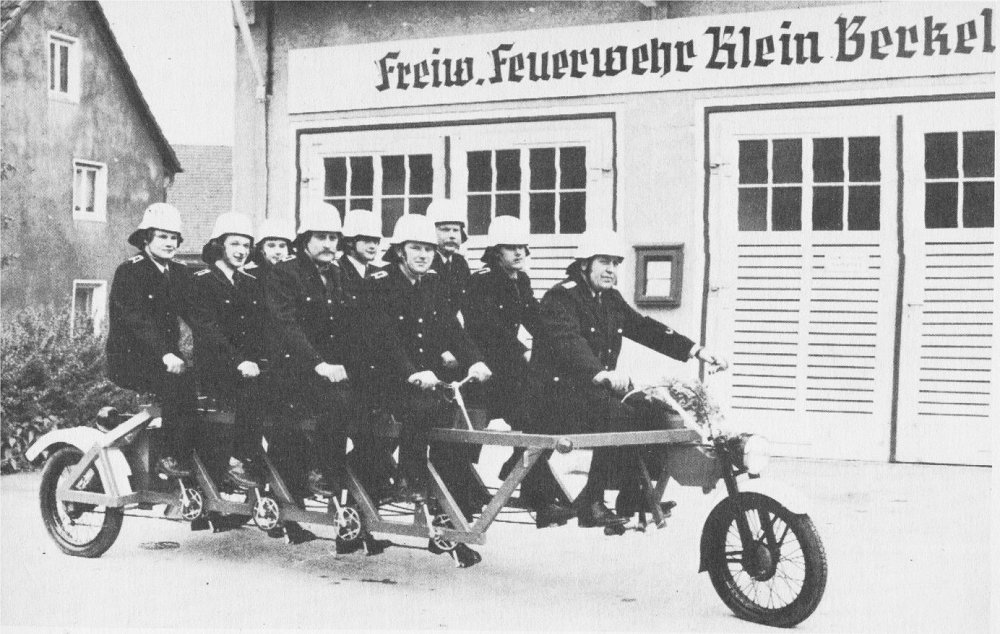 |
| Left: The Firefighting Tricycle: 195?
This heavy-duty tricycle carries four firepersons on each side, (including one and possibly two firewomen) with a ninth doing the steering. Each rear wheel is chain-driven by the four people on each side. The steersman appears to have his feet on a fixed footrest, and is not contributing to the propulsion.
The sign on the front of the building says 'Freiw Feuerwehr Klein Berkel' which translates as 'Volunteer Fire Brigade'. 'Klein Berkel' looks like the location name as there is a Klein Berkel district to the southwest of the pied piper town of Hamelin in Germany.
The date is unknown but it has a 1950's look to me.
Source: Further Transports of Delight by Spike Milligan. This is a collection of photographs with misleading captions that were intended to be humorous.
|
 |
| Left: The Firefighting Tricycle: 19??.
Klein Berkel still has a Volunteer fire Brigade, and here is a current picture of its station. Well, that settles that.
Unfortunately no other information about the tricycle has so far been found.
|
STEAM-POWERED TRICYCLES
 |
| Left: The Callihan steam tricycle: 1884
One of the early steam tricycles (for there were many) was designed by Edward Scott Callihan. It had a single wheel in front that was steered by two levers and two driven wheels at the rear. The driver sat behind the steam boiler on a seat taken from an agricultural reaper. The engine had two cylinders, and appears to have driven the rear axle directly. Maximum speed was a respectable 15 mph. Only one example was built.
You can read more about Edward Callihan here
|
 |
| Left: The Callihan steam tricycle: 1884
Note the steam-whistle just to the right of the chimney. The cylinder also to the right of the chimney appears to be a reservoir for lubricating oil. The valve just to the left of the boiler appears to be the throttle; a pipe runs from it on each side of the boiler to the engine cylinders.
|
For another steam-powered tricycle, see the von Sauerbronn-Davis steam velocipede on the Steam Bicycle page.
INTERNAL-COMBUSTION MOTORISED TRICYCLES
All the tricycles above were powered by foot or by hand, even if in some cases it was an elephant's foot. There were and are also tricycles powered by electricity or internal-combustion engines. There is a good selection of three-wheeled cars on the N-wheeled vehicles page, but all have bodywork (if sometimes not much) and none of them can be described as tricycles.
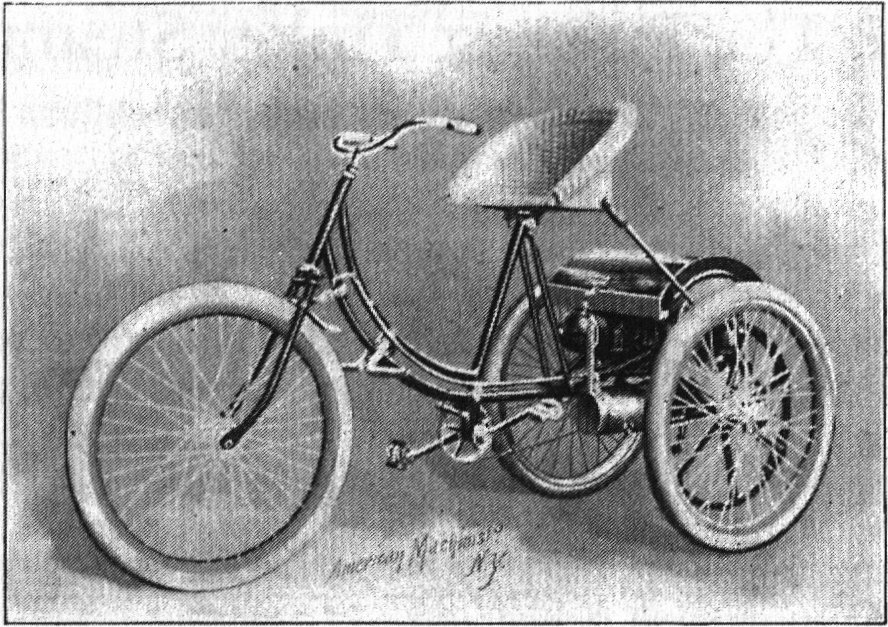 |
| Left: Motorised Tricycle: 19??
This motorised tricycle has the internal-combustion engine mounted at the rear, with drive to a large pulley inside the left rear wheel only. This suggest that the luxury of a differential was not provided.
Note that pedals are provided in case the engine can't cope. The T-shaped thing just behind the front wheel appears to be a foot-rest for use when 'light pedal assistance' is not required.
Source: American Machinist, date unknown
|
 ELECTRIC TRICYCLES
ELECTRIC TRICYCLES
 |
| Left: The Ayrton-Perry Tricycle: 1881
The first electric tricycle was built by British engineers William Ayrton and John Perry in 1881. It was first driven on Queen Victoria Street in London in 1882.
In 1881, Englishmen William Ayrton & John Perry built an electric tricycle with two large wheels at the front, with the left wheel only driven as no differential was fitted, and a small wheel at the rear which steered. Note that many accounts get this backward, and say the small wheel was at the front. Note that the back of the seat is cut away here to show the voltage-switching unit to the left. The electric motor is the long cylinder just below the seating platform; it is geared to the large gearwheel on the left. There seems to be only one stage of speed reduction, which implies the motor was capable of running effciently at low speeds.
Ten of Planté's lead-acid cells in series were used, providing around 20 Volts; the motor gave 1/2 horsepower. The speed was changed by switching the lead-acid cells on and off. The trike had a range from 10 to 25 miles and a maximum speed of 9 mph on a good road.
Ayrton and Perry's tricycle was the first vehicle to have electric lights, in the form of two small bulbs mounted above the main wheels. Each lighting attachment appears to have a small meter built in.
Steering was by the stirrup-shaped handle to the right of the rider's seat, which swivelled the rear wheel by a rod, and braking was by two shoes that gripped the tyre tread on the wheels, operated by the handle next to the left wheel.
The Ayrton-Perry tricycle has a Wikipedia page. (In German)
This image is probably from La Nature; Poyet was one of their artists.
|
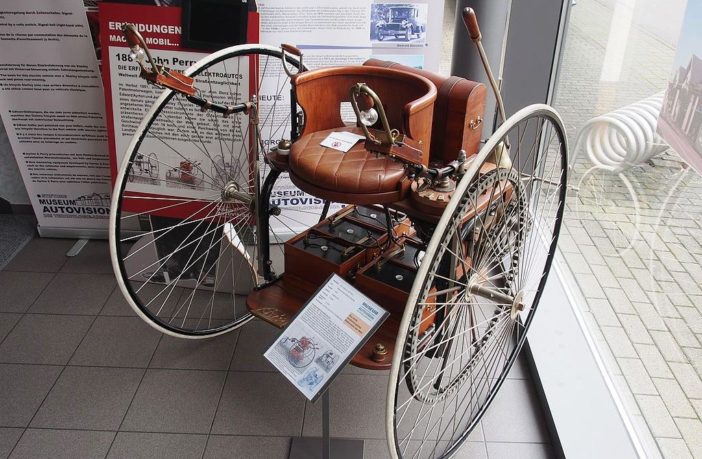 |
| Left: Modern replica of the Ayrton-Perry Tricycle: 2011
This replica was built by a team led by Horst Schultz, director and founder of the Autovision Museum in Germany.
There is more information here, which includes a video of the tricycle in operation.
|
 |
| Left: CAD rendering of the Ayrton-Perry Tricycle
Seen from the rear.
This CAD model is available from Turbosquid.
|
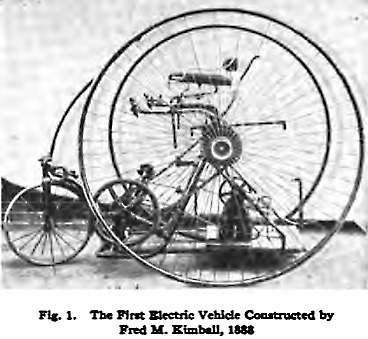 |
| Left: The Pratt-Kimball Tricycle: 1888
Philip Pratt's tricycle was constructed for him by Fred M. Kimball, of the Fred M. Kimball Company. There were 10 lead-acid cells, giving about 20 Volts, which powered a 0.5 HP electric motor. The rider sat over the axle, above the battery. The vehicle weighed approx 300 pounds (with the battery) and had a top speed of 8 mph.
The electric motor is the black thing below and to the right of the central axle. From it a belt drives a wheel to the left fitted with pedals, and from there what appears to be a chain drives the main axle. There is probably at least one more step of reduction at the motor end, so the pedals would turn at a rate the rider could keep up with, but this is not clearly visible. In this picture the battery does not appear to be installed; it would have been a sizable item.
Not a good-quality image but the best found so far.
|
 THE PORTABLE CONFESSIONAL TRICYCLE
THE PORTABLE CONFESSIONAL TRICYCLE
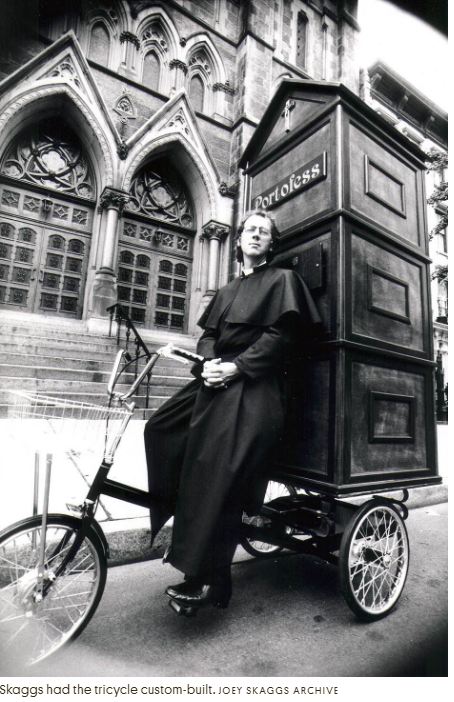 |
| Left: The Portable Confessional Tricycle: 1992
This is the Portofess portable confessional booth, mounted on a tricycle.
Things are not as they appear; this is a Prank. The Portofess Confessional Booth appeared at the 1992 Democratic Convention; it was the creation of artist and activist Joey Skaggs, seen here dressed as a priest. He said he was ready to take confession from any politician who wanted or needed it.
There is a great deal more information here. It is well worth reading.
|
 |
| Left: The Portable Confessional Tricycle: 1992
Skaggs used the fake name Father Anthony Joseph or, sometimes, Father William.
|
OTHER TRICYCLES
For three-wheeled cars, see the N-wheeled vehicles page.
For a steam-powered tricycle, see the von Sauerbronn-Davis steam velocipede on the Steam Bicycle page.
For a bizarre tricycle propelled by a fourth 'wheel' see Hemispherical Drive.
For an enormous armoured tricycle, see the the Tzar Tank on the Unusual Tanks page.
You can see the Pope tricycle cannon of 1895 and the Vickers machine-gun tricycle of 1901 on the Unusual Bicycles page. No, that's not logical but that's how it is for the time being.

























































 THE PORTABLE CONFESSIONAL TRICYCLE
THE PORTABLE CONFESSIONAL TRICYCLE





